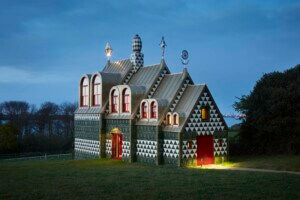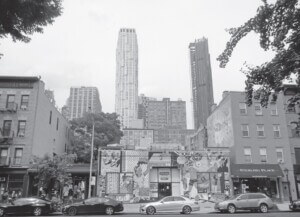A Purple Architecture: Design in the Age of the Physical-Virtual Continuum by James F. Kerestes, Ebrahim Poustinchi, and Vahid Vahdat | ETC Press | $65
“Purpleness,” in a new anthology, A Purple Architecture: Design in the Age of the Physical-Virtual Continuum, traces its roots to The Matrix (1999) and the famous choice Neo was confronted with between a red or blue pill. Essays within this volume continually reference the film, but argue that we now find ourselves with a third option, a “purple pill.” Edited by James F. Kerestes, Ebrahim Poustinchi, and Vahid Vahdat, A Purple Architecture offers readers a view into the blurring and overlapping worlds between the digital and the real.
This thematic spine is elegantly defined by the late architect and educator Janice Shimizu in “Mine the Gap,” where she writes, “Purple is not so much a third option but rather a gap that provides the ability to move between two established realms…the concept of purple architecture celebrates a fluid and relative condition of multiplicity.” Read on, and imagine purpleness more as a productive dialectic than a path of compromise.

The book object itself fittingly transcends the traditional medium of print with augmented reality overlays and a suite of interactive features (also, it’s available for free download on the publisher’s website). The curators divided the book to create a choose-your-own-adventure story, curating groups of projects under different themes. The reader can navigate three different “books:” Spatio-Visual Regimes, Post-Screen (my chosen experience), and Existential Scenarios. Each project appears in each book, but the context differs. Supporting the idea of simultaneous alternative realities, projects can be read differently even when the reader is presented with the same text and images. Of course, this means the book isn’t experienced chronologically: it’s hard to sense how much “progress” you’ve made in the traditional page-number sense. But the medium disrupts expectations, providing both frustration and wonder. In keeping with the thesis, this seems to be exactly the point.

In his opening project in the book, Purple Playthings, Joseph Altshuler references fellow Chicago architect Sam Jacob, who wrote in Make it Real: Architecture as Enactment that “architecture operates in an illegible, liminal state between fictive ideology and material reality.” Overall, the book and its contributions privilege fictions and realities while sometimes leaving ideology and materialism’s roles within them undercooked: for instance, Leftists see the fictive Tatlin’s Tower as symbolic of revolution and liberation, while capitalists see it as the apex of authoritarian oppression.
Friedrich Engels and Karl Marx defined their conception of materialism as where socioeconomic and political relations are grounded in concrete, real-world conditions. There is an obvious correlation to architecture here; it deals literally with concrete material as a medium for ushering ideology into the world. Even virtual architecture is grounded in the material conditions of its production and interactions. As Ryan Scavnicky writes in his essay, “Let Them Have Meta-Virtuality,” there is no such thing as pure space—“only mediated space, our shared physical environment overlaid with meanings from the way it is produced and subsequently memorialized via media.” Or, to put it in Zizekian terms, our shared physical environment is simply an overlay of multiple meanings expressed and interpreted via ideology.

A Purple Architecture argues that alternate realities emerge when we defamiliarize ourselves with these environments, disturbing the known to open multitudes of possibility. But this thesis can become idealistic, as not all alternates are necessarily desirable. It runs the risk of falling back into postmodern pluralism again, with its close friend neoliberalism lurking close behind. It could be misconstrued as simple reformism instead of something far more radical.
Learning to take a critical stance toward the very foundations of our realities is a worthy goal, but even QAnon conspiracy theorists are “critical” of the reality they think they see. The future we propose must transcend idealistic thinking, and instead work to map out the material conditions of how we get there—a set of construction documents. This future must be so irresistible it is above reproach, and above ideological prejudice.
Thankfully, many projects in the book are irresistible.

Sink Your Teeth into Dessert by Altshuler’s firm Could Be Design is a case study in their proposed Matrix of Architectural Playthings. The design occupies two scales simultaneously: a sink fixture with intestinal PVC piping doubles as a scale model for a kind of playground installation.
Andrew Kovacs documents the shipping and rebuilding of The Chicago Model, Proposal for Collective Living following the 2017 Chicago Architecture Biennial. The project is a massive toy model, a grown-up psychedelic dollhouse. In the essay “Power Jokes,” Ayad Rahmani argues its production is also a figurative model for collective practice and cooperative labor. “Make no mistake about it: Kovacs’ model is a critique of capitalism and an economic system that for years had biased ends over means and consumption over production.” Despite sharing no floorplans or a clear understanding of how collective living actually happens in the form of this project, it almost doesn’t matter; it’s so compelling and foreign that I want to experience it firsthand anyway.
NFT House and Lightweight Construction by Galo Canizares and Stephanie Sang Delgado of office ca exploit and play with the paradoxes of architecture and the software used to create it. If “software eliminates the memory of labor by prioritizing finished work (renderings, drawings, models)…” as they claim, these projects re-center the methods of virtual production integral to architectural labor today.
Finally, the editors Poustinchi and Kerestes present their project The Secret Life of the Ring, the architectural corollary to the book, a proposed installation of AR-triggering lollipops, fabricated blobs, mirror balls, and inflatables. The extension of the project into the virtual realm overlaid upon the physical reflects the social media concept of “engagement,” giving visitors and “users” agency in shaping their environments. It becomes a way of mediating physical space, to return to Scavnicky, in the same way filters and overlays on TikTok augment virtual spaces. These architectural filters expose the dialectical friction between physical and virtual, reality and fiction, ideology and material—a third “purple” option. These futures are compelling; let’s figure out how to get there.
Davis Richardson is an architect at REX and has taught at NJIT and the Architectural Association.











